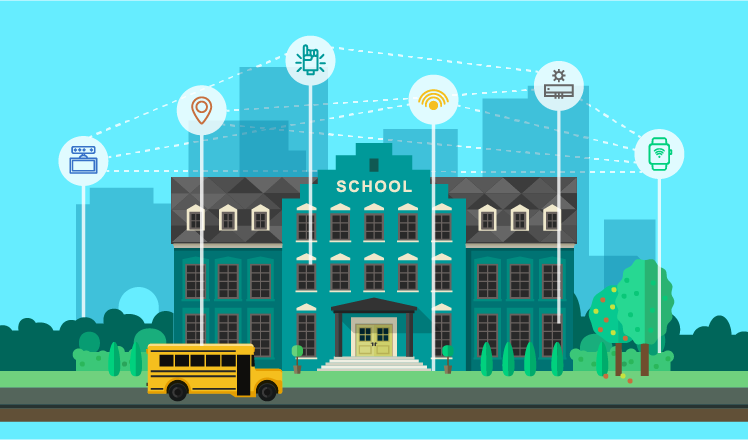How IoT influences education
For years, we have known the Internet as the global computer network helping us to connect with other people and share information via computers, smartphones, tablets and other devices. With the evolvement of the Internet of Things, the range of such devices is significantly increasing. Moreover, smart connected things can not only collect data with the help of sensors, but also, after analyzing sensor data, perform certain actions with the help of actuators.
Today, IoT is transforming various industries, and the education domain is not an exception. If we effectively employ IoT in education (A solution build on a reliable architecture), we can not only improve the process of giving and getting knowledge, but also make educational institutions more convenient and secure.

Some cases of IoT-enabled education
Enhancing online connectivity
Imagine a scenario when learners sitting at their desks at home or in a classroom can communicate with their classmates, educators, and mentors scattered all over the world. Or, let’s say, the activity of the day is focused on sea life. To provide a highly educational and a really exciting experience to their students, teachers decide to access the information generated via live feeds and sensors monitoring water bodies.
Sensor gloves
Sensor gloves connected to an IoT system can be used for teaching sign language to children. When a learner wearing a sensor glove makes a sign, an IoT system fetches the signal and analyzes it. Comparing a learner’s sign with the correct sample, a control app can provide a learner with the feedback on his or her signing accuracy.
Other wearable IoT devices
Wearable IoT devices like virtual reality headsets, watches, and fitness bands may soon find their way into classrooms. The IoT enabled headbands report the activity of a student’s brain to a mobile app. This could help teachers track students’ learning styles and monitor student engagement.
Improving learning environment with IoT
HVAC
The major purpose of a HVAC (Heating, Ventilation, and Air-Conditioning) system is to provide thermal comfort and maintain good indoor air quality via proper ventilation with filtration. A smart HVAC system is equipped with the capability of decision-making and can help a school save energy and money by functioning only when required. For example, a smart HVAC system will give the commands to control air flow and temperature (for example, it can set the temperature according to the weather outside).
Radio Frequency Identification (RFID)
One of the potential applications of IoT at schools is tracking the attendance automatically with the help of radio frequency identification (RFID). An RFID chip could be embedded in a mobile device or student’s ID and would be constantly trackable. With the help of this device, the teachers will be able to know if the student is at school and their location in the school. By analyzing this information, teachers can identify regular absentees, find out the reasons for absence and act accordingly.
GPS for school buses
A GPS-enabled school bus can be tracked by administrators and students. This way, they will be able to know where a school bus is at any given time. In addition to this, the students can be notified when their school bus arrives at their pickup location thus eliminating the need for waiting.
Wrap-up
The IoT has the potential to dramatically transform the process of giving and getting knowledge as well as improve learning environment.
The online connectivity can help foster joint communication and engagement among the students and teachers residing in various cities and even countries. Education can be also enhanced with various wearable IoT devices. Smart schools may use IoT to track student attendance, monitor school buses, control lighting systems, improve security and more.
These are just a few examples that depict the significance of IoT in this sector, and IoT can offer a lot more to the world of education.


